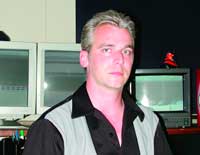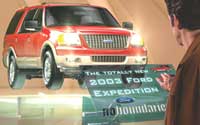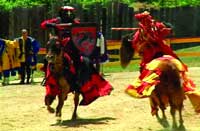
Pat Batrynchuk of Bullet Digital employs DPS Velocity on his work for the weekly series Behind the Lens. He's now operating Version 8.
|
The marriages between editors and their nonlinear editing systems are thriving. Most editing facilities interviewed claim to have found the right match for their needs. If they want anything more, it's mostly an expansion of what they already have. At least that's the story until manufacturers turn their heads with a new glamour product.
BETTER EDITING THROUGH OPTIONS
For Jim Rubino, film editor at Slingshot Post in New York City (www.slingshotpost.com), the Avid Symphony 3.1 continues to do the job. He comments, "When it first came out, most editors were using it as an online tool. I always used it offline as well. It has the realtime effects, the speed and the amount of storage I need. The effects palette gives you so many controls you can manipulate anything you want. With 24 video tracks, I can do multiple layering. So the effects and the speed makes you a better editor by giving you more options."

Slingshot's Jim Rubino used Avid Symphony on this multilayered spot out of Lloyd & Co. for Gucci.
|
The Symphony was recently used in a Gucci commercial via agency Lloyd & Co., New York. Destined for Europe, the spot required multiple layering, with a number of split screens involved. Says Rubino, "With the speed of the Avid, I could see the effects almost immediately, and we could decide then and there if we liked them or wanted to change them."

Slingshot's Jim Rubino
|
He advises future Symphony users: "Press all the buttons and see what they do. Just playing around with it can give you some ideas. Some of the better edits I've made were mistakes - just hitting something by accident."
Meanwhile, Rubino's fellow film editor at Slingshot, Billy Senia, is using the PC-based Avid Media Composer 10.3, vs. the Mac-based Symphony 3.1. He notes that the features are fairly similar, except the 10.3 allows color correction.
"These systems allow a filmic look that gives you more production value," Senia holds.
WISH LIST: Senia's includes more uncompressed video layers for better quality and speed. Also, more realtime effects, meaning less rendering.
THE BENEFITS OF SPEED
Already owning two Media 100 XRs, Drive-Thru Productions in Minneapolis (www.drive-thru.tv) recently installed an 844X system. Director/cameraman/editor Bob George likes its four streams of uncompressed, 10-bit video, all with alpha channels.
"It allows me to work almost as fast as I can think because of the realtime nature of all of the video streams," he says. "I can have eight streams of uncompressed video going on, and the time it takes to process them together is the time it takes to play through once in realtime. Clients can now sit here and say, 'Let's move that up a frame,' and you can take care of that in realtime and see it instantaneously. This is as close as you can get to Fire and Flame work at half the cost - maybe a third. You have all that realtime ability at your offline rate."
A recent project was a spot out of Nelson Henry, Minneapolis for Fiber Choice, a chewable fiber supplement. With a tight turnaround, the commercial was shot in high definition for a film effect and transferred to Digital Beta. Offlining in 844X, the facility worked with some product-comparison graphics that added up to about seven layers.
George recalls, "We were able to put it all together in front of the client in realtime, and the agency took it to the client after a day and a half of cutting. That same day, they wanted to rework the spot, and we did it in about an hour and 15 minutes."
He notes users of the 844X have to think differently: "When you're also working in After Effects, Combustion and Commotion, you don't marry your graphics layers to your video layers anymore. You're dealing with a faster workflow, so you no longer have time to check your e-mail while you're working."
WISH LIST: "It would be nice to see one program have more of everything you need in terms of tracking, layering, vector paint and wire removal tools. But I think the 844X is on its way to being that."
SUPPORT IS A HOT ISSUE
Finish Editorial (www.finishedit.com) in Boston continues on its upgrade path. In addition to having the SGI Octane, it recently upgraded its Onyx 1 to an Onyx 2. Both Discreet Smoke, on the former, and Discreet Fire, on the latter, have also been upgraded. Editor Eamonn Conway reports that Fire affords greater speed and is used on the more graphics-intensive edits. Upgrades were made in anticipation of more HD work.

Finish editor Eamonn Conway's tools include Smoke and Fire. In the future he'd like to see QuickTime import.
|
In a facility where each editor can work in all of the suites, handling a job from beginning to end, both Smoke and Fire permit timeline editing for longer form programs. "We do that rarely," Conway interjects, "because you come up against storage issues, with Smoke and Fire being uncompressed."
Fire's spark packages and motion graphics came in handy in a spot for ATI Radeon, maker of graphic accelerators for PCs. The spot showed flaming arrows being shot from a computer at its operator. Fire allowed compositing of multiple layers in one operating system while using third-party effects and adding motion-tracked elements.
There's a lot of support out there for Smoke and Fire, Conway points out. In addition to Discreet's reachable, well-qualified support people, he notes, there's a helpful user-originated Web site: www.fxguide.com.
WISH LIST: In the future, he'd like to see QuickTime import into Smoke and Fire, as well as more resolution independence, affording the ability to work on different resolutions on one timeline.
AN AFFORDABLE VARIETY
Jeb Johenning, partner in Beverly Hills, CA's Ocean Video (www.oceanvideo.com), says his past experience has been with Media 100 systems, which he continues to use, but he has found new advantages in running Apple Final Cut Pro on the Pinnacle CineWave.

Grace & Wild used Quantel's eQ with Henry Infinity on the "No Boundaries" campaign for Ford Motor Co. out of JWT. Footage was shot with a Panasonic AJ-HDC27 HD camera.
|
"CineWave has a scalability from consumer-level equipment to the professional level," he says. "There are very few systems that allow you to use so many formats without having to relearn any new procedures. You can plug in a $500 8mm video camera or a $100,000 Sony HD system. When you're buying new technology that's changing nearly by the week, it's hard to tell which will prevail. This gives the professional user of average means an affordable solution."
He points out, "The sooner you can get past the equipment side and learn the tool, the faster you get involved in telling the story. Apple's FCP, at only $1,000, gives you the opportunity to have virtually the same tools you'd have in a system costing 100 times the price."
Ocean worked on a high definition project with Santa Monica's Bellies Productions - an experimental film that was shown at the annual convention of the National Association of Television Programming Executives (NATPE). This was edited in CineWave, even though it was shot and screened in HD.
Johenning steers users of the gear to the Web site, www.2-pop.com. Although it was user-originated, it enjoys the participation of both Pinnacle and Apple.
WISH LIST: Johenning wants "less rendering and more realtime."
HIGH EQ
Happy with the performance of the Quantel Henry and Editbox, Grace & Wild (www.gracewild.com) in Farmington Hills, MI, has recently positioned itself for high definition work with the manufacturer's eQ. Paul DeMars, director of technical operations, favors the Quantel approach because "they actually make processors for video post production as opposed to those who simply make processing computers. This makes it a much more efficient operation. You have a much faster processor, especially with the eQ.
"Even in the Henry and Editbox, the hardware is made to be video specific, so digital technology is consistent throughout the Quantel boxes and the colors always conform to SMPTE standards." While DeMars finds Henry and Editbox, in standard definition, to be strong, efficient and user-friendly compositing tools, he points to the resolution-independence of eQ for the HD world. He notes, "You can mix and match whatever level of video that you have to use."
A recent project for J. Walter Thompson, Detroit, the "No Boundaries" campaign for Ford Motor Co., brought about the union of eQ with Henry Infinity. In this motion control project, Luminary Films, Detroit, shot all elements on a Panasonic HD camera at 24-, 12- and 6 frames per second so that the camera would progressively create blurriness. DeMars notes that, with the Panasonic camera recording metadata, this was recorded on HD videotape.
"The eQ saw that information and knew how to play it back properly to maintain the film look without the operator having to go into speed-up or slow-down processes," he notes.
To future eQ users, he points out, "Their editing software is very interactive and fast, so you can expect very efficient editing. It can import any type of computer file and turn it into a video file quickly."
WISH LIST: He's withholding any HD purchases until the industry gets enough experience in the medium.
EFFICIENCY
"There's no other choice," says Richard Miller, CEO of Guardian Entertainment (www.guardianltd.com) in New York, in reference to the Sony Xpri. A chief benefit, he reports, is not having to downconvert tapes and conform the timeline. The production and post facility shoots on a Sony F900 HDCAM, part of the CineAlta line. The tape is then put into an HDW500 deck, a multiformat deck that will handle 24 fps, and the 24-frame original is digitized to the Xpri, all in the native format. After the Xpri is used to edit the footage in the original format and frame rate, the result is outputted to HDCAM tape.
Miller holds that Guardian can be highly cost effective because Xpri reduces post production time by about 35 percent by not necessitating resolution or frame rate conversion and also saving the cost of offline editing and conforming.
Because everything was in one box, Guardian was able to work efficiently while posting the independent film Out of the Darkness. The box offered full color correction, a couple hundred special effects and built-in CD audio importing, as well as the ability to do both standard and HD editing.
Miller advises those using Xpri for HD editing to make sure the DPs also know their HD stuff - for example, using the correct frame rate. Guardian has been using the Xpri 3.01 and is now beta testing the Xpri 4.0.
WISH LIST: He believes Xpri 4.0 "will do all the things I want to see, adding a lot of new functionality to the hardware."
FREE TO EXPERIMENT
Heath Firestone, producer/director at Firestone Studios (www.firestonestudios. com) in Denver, has been going the Matrox route for nearly three years, owning four RT2000s and one 2500.

Firestone Studios used the Matrox RT2500 and 2000, running with Premiere, to edit this spot for the Colorado Renaissance Festival.
|
"At the time it came out," he says, "it was the only reasonably priced realtime system. It meant capturing MPEG-2 and also getting cleaner edges with 4:2:2. This gives us better-looking keys and, with the realtime system, it speeds up our workflow. We can be more experimental because we don't have to wait for things to render."
Matrox, which comes with Adobe Premiere, was used in a tightly scheduled commercial for the Colorado Renaissance Festival. Firestone had a day and a half to edit three hours of footage down to three distinct :60s. "Since we had realtime color correction," Firestone notes, "we were able to tweak all of our settings."
For those looking to spend under $1,000, "these are the most versatile realtime capture cards out there," he notes, adding that Premiere has plug-in capability with any Direct X audio program.
WISH LIST: He would like to see some inexpensive HD editing capabilities.
THIS BULLET'S VELOCITY
A user of DPS products for about six years, and of its Velocity for two and a half years, Pat Batrynchuk, senior online editor at Bullet Digital Post (www.bulletdigital.com) in Toronto now is looking forward to working with dpsVelocity's Version 8, which started shipping in mid-June. He says it has the one asset he was missing - multicamera editing.
Speaking of his current Velocity, he comments, "It's very easy to get around both small and large timelines. The architecture of the timeline is very open and image quality is wonderful. Their compression codecs are very good. It is also fully uncompressed, which we take advantage of for onlining TV series."
With Eyeon Digital Fusion effects and compositing integrated into the system, Batrynchuk can have a video clip on a timeline and right-click on it for a menu that will send the clip to DF. This opens that application with the chosen effect applied and ready to animate, then updates the clip back on Velocity's timeline.
Velocity is a significant help to Batrynchuk when he does his weekly work on Behind the Lens, a series on directors, photographers and camerapersons shown on the City TV network and produced by Keep It In The Family Productions, operating in the same building as Bullet. He points to Velocity's ability to composite quickly. He also finds it useful in handling the abundant greenscreen material.
"When I use the Velocity keyers," he elaborates, "it works well and renders quickly. And all the text and titling is in realtime."
He recommends to future Velocity users: "Keep an open mind and look at it as a new thing rather than as another Avid or Media 100."
WISH LIST: His wish has been answered with the introduction of the dpsVelocity V.8.